February 28, 2018 PTAB Trial Statistics
Trial Statistics from the Patent Trial & Appeal Board
As of February 28, 2018, the Patent Trial and Appeal Board (“PTAB”) has updated the monthly statistics of the number of inter partes reviews (“IPR”), post-grant reviews of covered business method patents (“CBM”), and regular post-grant reviews (“PGR”) that have been filed. These stats on progress are shown below, and can be found at:
https://www.uspto.gov/ip/boards/bpai/stats/aia_trial_statistics.jsp
The graph/chart form of these statistics with some explanations can be found here, which includes proceedings and progress statistics:
https://www.uspto.gov/sites/default/files/documents/trial_statistics_20180228.pdf
IPRs Are the Most Filed Petitions
The first regular PGR (not for a CBM) was filed on August 5, 2014. As shown below, there are now 98 PGR petitions that have been filed. We are now approaching the four year mark since that first filing. Thus, there has not been a strong ramp up even though more and more patents qualify (must be a first-inventor-to-file patent). Maybe if Congress reduced the scope of estoppel (eliminating the “reasonably could have raised” language) there will be more in the future. Here’s the breakdown of the 8,210 AIA petitions (7,573 are IPR) filed from September 16, 2012 to February 28, 2018:
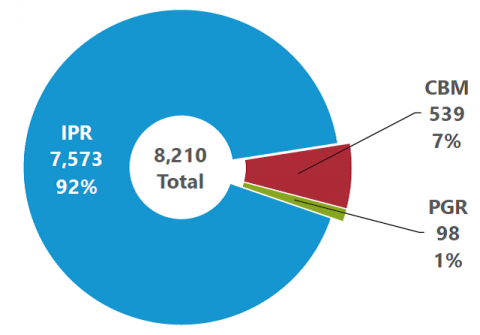
Here the breakdown by technology, the majority still being electrical/computer arts, for the fiscal year 2018 (which started Oct. 1, 2017):
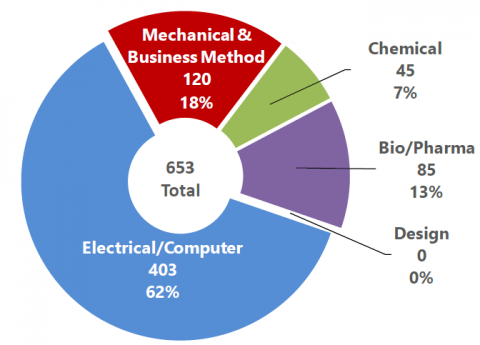
To break down the filing trends for IPR, CBM, and PGR separately on a monthly basis for the 13 months, here are the graphs provided by the PTAB. The IPR filings have been steady and relatively high the past year, with an unusually high number (195) filed in June of 2017:

However, the number of PGR petition filings is still relatively low (single digits every month), and the number of CBM filings are decreasing:


Institution, Disposal, Etc.
In the first phase of an AIA trial, the PTAB determines whether or not an IPR, PGR or CBM will be instituted. The PTAB may not authorize the IPR unless the petition and response shows there is a “reasonable likelihood” that the petitioner would prevail with at least one of the challenged claims.[1] The institution of a PGR/CBM trial requires an initial threshold requirement of “more likely than not,” which may be the same or slightly higher than the IPR threshold standard. However, the latest statistics clearly show that the initial threshold has been met the majority of the time. Below are charts depicting the filings for IPR, CBM and PGR, respectively, clearly indicating that the majority of filings lead to institution in IPR, but the trend is going down starting from Fiscal Year 2013 (“FY13”) to February of this year (as of 02/28/2018, it is 62% overall for all technologies):
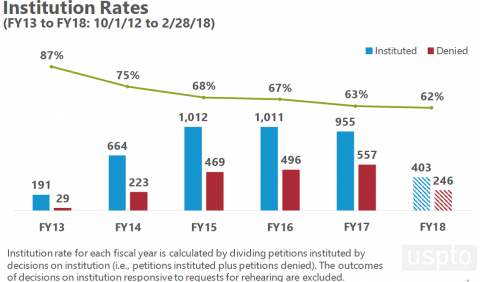
Here’s the breakdown of institution rate by technology (the rate for bio/pharma seems to be increasing):
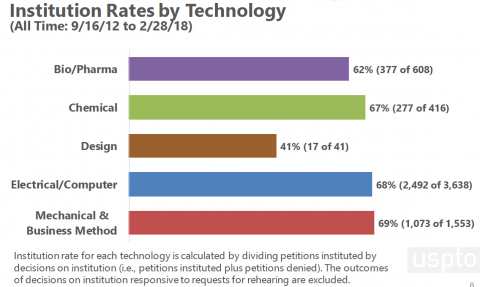
When the IPR/CBM/PGR Petition is filed, the Patent Owner has the option of filing a Patent Owner Preliminary Response (“POPR”). With the old reexamination proceeding, the Patent Owner typically does not file such a preliminary response. But with these AIA trials, the Patent Owner wants to avoid institution of trial, and filing the POPR can avoid such institution. Thus, in all technologies, the POPR is usually filed (the “pre” refers to before the rule allowing testimonial evidence with the POPR; “Post” refers to the rule allowing testimonial evidence with the POPR). However, the recent SAS decision by SCOTUS may change the filing rate, since the PTAB must now institute on all claims or nothing. For instance, why would the Patent Owner fight for a few claims know that if the other claims will be instituted, those few claims would also be instituted per SAS?
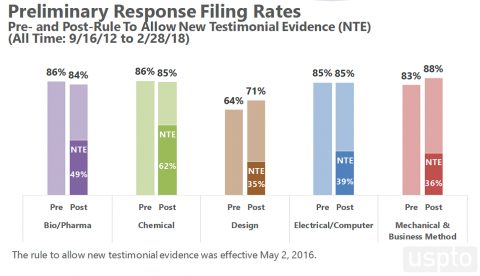
Regarding settlement, there are more settlements in IPR pre-institution, whereas in CBM there are more post-institution. The graphs below show settlement currently occurs around 13-14% pre-institution decision; around 21-22% post-institution:
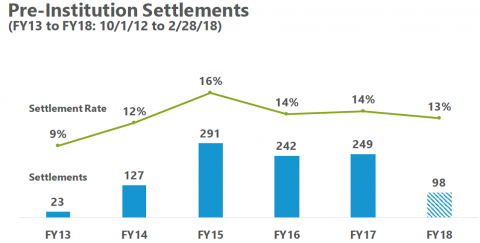
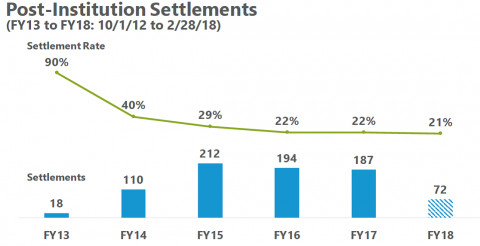
Below is another PTAB chart showing the break-down of outcomes for those IPRs that have been completed to date (again as of 02/28/2018). Out of the 8,210 total filed petitions, 4,256 trials were instituted. You can see that 2,000 petitions were denied, 1,030 settled pre-institution, 793 settled post-institution, a total of 123 (77+46) dismissed, and 296 (31+265) had the Patent Owner requesting adverse judgement.
The real question is what happens to those claims once there is institution and there is a Final Written Decision (“FWD”). Of the 2,000 trials that proceeded to final written decisions, and 65% of them had all claims found unpatentable, and 16% had some claims found as unpatentable. 19% of time had no claims found unpatentable (all claims survived) (no great for Patent Owners).
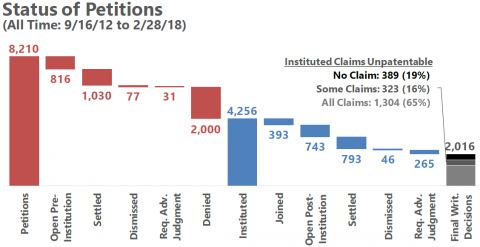
[1] 77 Fed. Reg. 48764 (Aug. 14, 2012).

